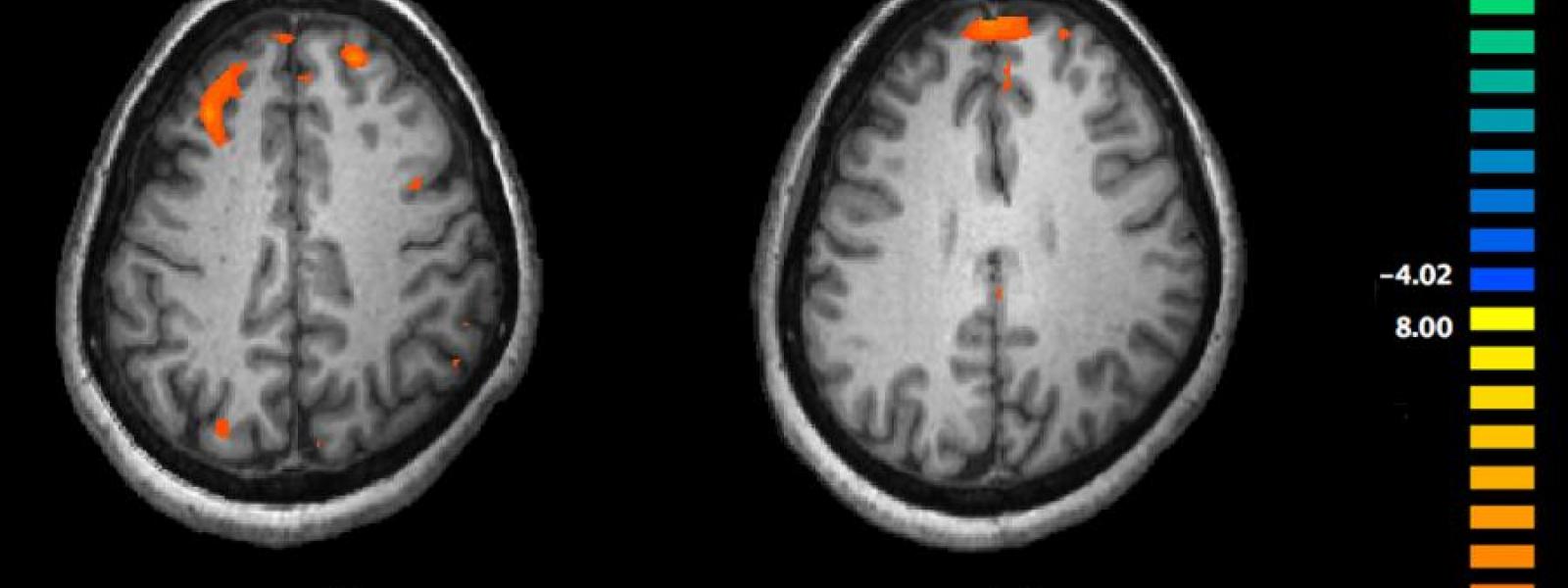Effect of Age on Brain Vascular Permeability
Principal Investigator: Issam A. Awad, MD PhD (Surgery)
Summary: The aging brain involves chronic vascular pathology, causing ischemic and hemorrhagic changes, and cognitive decline.
Effort-Reward Decision-Making in Math Anxious Individuals
Principal Investigator: Sian Beilock, PhD (Psychology)
Summary: Many individuals report strong feelings of tension, apprehension, and fear of math. This emotional reaction, termed math anxiety, has long been associated with avoidance of math and poor math performance.
Drug Effects on Neural Responses to Stimuli
Principal Investigator: Harriet de Wit, PhD (Psychiatry and Behavioral Neuroscience)
Summary: The goal of this study is to examine the effects of a stimulant drug on brain activity while participants view images of varying sensory complexity.
Aesthetic Sensitivity, Art Education, and Empathy
Principal Investigator: Jean Decety, PhD (Psychology)
Summary: This project employs fMRI to characterize the neurocognitive mechanisms underpinning aesthetic evaluation.
ability to feel emotions including love, compassion, hate, grief, and shame. The capacity for empathy, in particular, represents a powerful means of identifying with others and plays a critical role in aesthetic sensitivity. A competing theoretical perspective, however, postulates that emotional distancing is central to aesthetic evaluation. Imaging data will be integrated with dispositional and behavioral data to determine whether empathy or distancing is necessary for the aesthetic appreciation of paintings, as well as the role of art education in facilitating the relation between empathy and aesthetic judgments. Although aesthetic experiences are frequent in modern life, there is as of yet no comprehensive theory that explains what constitutes such experiences. The proposed research cuts across disciplinary boundaries between psychology, aesthetic sensitivity and art education, thereby moving beyond current academic knowledge relating to this unique aspect of human nature. Pilot data will be used to support a full proposal to The National Endowment for the Arts.
The Effect of Nitrous Oxide on Front-Limbic Circuits in Aggressive Individuals
Principal Investigator: Sarah Keedy, PhD (Psychiatry & Behavioral Neuroscience)
Summary: This is a pilot study to determine if inhalation of Nitrous Oxide (N2O; AKA “Laughing Gas”) will reduce fMRI Bold responses to exposure to angry emotional faces and/or increase fMRI Bold responses to viewing socially ambiguous videos in cortico-limbic circuits.
Mental Imagery in a Foreign Language
Principal Investigator: Marc Berman, PhD (Psychology)
Summary: Mental imagery is a fundamental cognitive process often elicited via language.
Effect of Electrical Stimulation on Brain Activity During Recollection Attempts
Principal Investigator: David Gallo, PhD (Psychology)
Summary: Electrical brain stimulation with transcranial direct current stimulation (tDCS) has the potential to significantly advance our understanding of human cognition, but the technique’s validity has been questioned.
improve episodic memory, or the ability to accurately recollect past events (Gray et al., 2015, Cortex). Since then, we have replicated this tDCS effect twice, discovering that AM testing is key to finding reproducible tDCS effects in younger adults. Using this same task in several fMRI studies, we also have found robust modulation of dlPFC activity as a function of recollection difficulty (for review, see Gallo, 2013, Current Directions in Psychology). Here, we propose the first study combining tDCS and fMRI to investigate episodic memory retrieval, testing the hypothesis that dlPFC is causally involved in retrieval processes that regulate recollection accuracy.
Neural Alterations Associated with Hallucination Propensity in Borderline Personality Disorder
Principal Investigator: Sarah Keedy, PhD (Psychiatry & Behavioral Neuroscience)
Summary: This study aims to map this potential neurophysiological overlap of BOR with the major psychotic disorders schizophrenia, schizoaffective, and bipolar disorder.
The Neural Correlates of Learning Through Gesture
Principal Investigator: Susan Golding-Meadow, PhD (Psychiatry & Behavioral Neuroscience)
Summary: This project investigates the neural processes that underlie learning with gesture.
neural mechanisms by which gesture may promote learning and test the predictions of these mechanisms in two sets of studies. The first study (Aim 1) uses fMRI to measure the neural processes that underlie learning in a gesture-observation paradigm. We use these whole-brain data to fully explore the predictions of these mechanisms and establish which regions are involved during this learning process. To investigate the neural processing that underlies learning via gesture-production and spontaneous gesture-production, we turn to fNIRS, which permits movement during neural recordings (Aim 2). We use the fMRI results of Aim 1 to identify regions of interest for the fNIRS recordings. We also conduct a parallel gesture-observation study using fNIRS, which allows for a direct comparison of gesture-observation and gesture-production. Broadly, the results of these studies will inform questions about the mechanisms that underlie learning, the mechanisms by which gesture facilitates learning, and the neural correlates that underlie spontaneous gesture production.
Functional Mechanisms Underlying Abnormalities of Fidgety Movements in Three Month Old Infants Following Perinatal Brain Hypoxia-Ischemia
Principal Investigator: Jeremy Marks, PhD MD (Pediatrics)
Summary: Perinatal brain hypoxia-ischemia in newborns results in a spectrum of neurodevelopmental outcomes, from no disability to intellectual disability and cerebral palsy.
